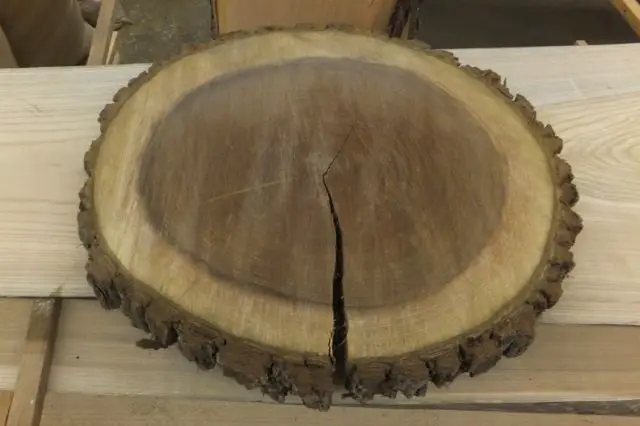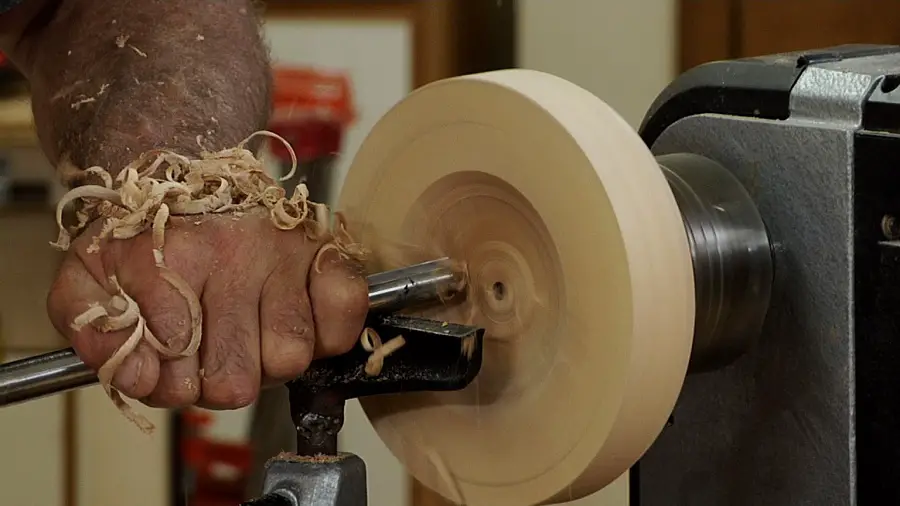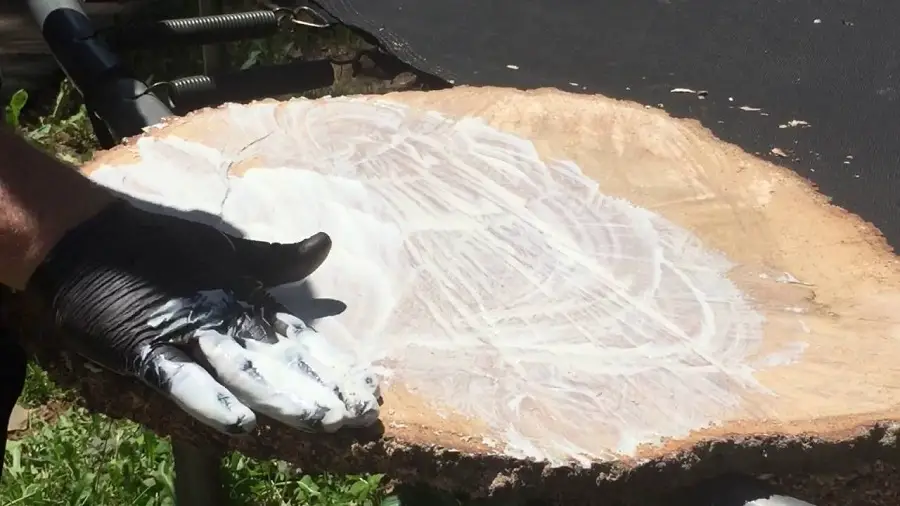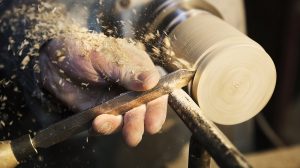I have received many questions over the years about how green wood can be stabilized so that it stops cracking, what needs to be done to make drying faster and without big losses, or how to make wood stronger so that it can be processed easily without cracking. Each time I have tried to give answers that are as well researched as possible. The other day we had a discussion on this subject again and I thought it would be good to put it all together in an article. So I will tell you what I have learned about stabilization of green wood, about substances that can be used to make the drying process as fast as possible and with minimal losses, and about drying treated wood.
Why wood needs to be stabilised
Among woodworkers, there are many who do not have dryers or do not always buy industrially dried wood in dryers with programs tailored for plank thickness, wood species or final moisture content. They buy wood from various sources or cut it from their own garden and want to process it as quickly as possible. It is known that natural, stack drying can take years. In order to process it as quickly as possible and reduce losses, the wood needs to be stabilized.
Another category is those who turn wood to make bowls. Such an object can be made from a whole piece of wood or from pieces glued together. The latter is simpler. The pieces of dry wood are glued together and the resulting piece is turned into a bowl. As the wood is dry, there are no cracking problems, and the fact that the pieces are glued together eliminates tension.
But what happens when the bowl is made in one piece? We know that wood needs to be sliced in order to dry properly, but in this case this is not possible. Then it has to be turned before drying, under certain conditions, and the resulting bowl has to be stabilized so that it does not crack.
Another example of wood in need of stabilization: logs from branches. The branches are certainly not brought to equilibrium moisture, and the logs can crack during drying. But logs from trunks have the same fate, and cracking can be avoided by stabilization.

How can cracks be avoided? What are ways to get rid of water faster?
Even if the wood is green when processed it will not stay that way. Wood drying is a natural and long-lasting process that starts immediately after felling. As the water comes out, tensions build up inside the wood. Rebalancing leads to cracking and warping.
The process doesn't stop until a equilibrium humidity which is dependent on outdoor humidity. That's why indoor wood has an equilibrium moisture content of 10-12% and outdoor wood 14-16%. And that's in our climate zone. In other parts of the world the equilibrium humidity may be different from here.
By processing a green or totally untreated wood we can expect the resulting object to warp or crack. This is why measures must be taken.

1. Sealing the fiber ends
Fiber end sealing is the simplest method of slowing down the outflow of water from the wood, thus reducing stresses and losses. This method is also applied when industrial drying is done - the ends of the planks are sealed with different substances. For sealing you can use wax, paraffin or paint. The end of the fiber will be sealed and will no longer allow the water to flow out very quickly, but gradually, without tension.
For those who make bowls it is possible that the following method of gradual turning to help them. The green wood is turned until the walls reach a thickness that is 101TPTP3T of the diameter of the pot. It is then coated with wax so that the ends of the fibers are covered and placed in a paper bag along with some green sawdust left over from the turning. The bag is put in a cold place in a pantry for a few days and then moved to a warmer place. It is recommended that the bag is initially placed on the floor, and after a few days it is moved to the first shelf and so on up to the warmest part of the room. The jar is kept like this for a few weeks until it reaches close to equilibrium humidity, after which turning is continued to the desired size. Finally, to allow the wood to exchange moisture with the environment, it is finished with wax or oil.

2. Techniques for faster water removal from wood
There are more drastic methods of water removal, but these can be applied to smaller pieces of wood. The idea is to attack the walls of the cell and the water comes out more easily. The most popular are:
- Boiling the pieces of wood - by boiling the water enters the wood and pushes into the cell walls weakening them. When the pieces of wood are put out to dry the water that enters during boiling also trains the wood and so drying takes place faster.
- Freezing wood - pieces of wood are put in the freezer. The water in the wood freezes, increases in volume and forces the cell walls. When the wood is taken out and allowed to thaw, the water inside the cell comes out more easily. There is also the possibility that the wood can be left in the freezer for longer and the water will come out as it does from a piece of meat put in the freezer. The time is long, however, and still more has to be left out to reach equilibrium.
- Soap solution treatment - the wood is immersed in a 1:1 solution of liquid soap (regular soap) and water and left for 4-5 days to 2-3 weeks, depending on the species (harder wood is left longer). It seems that the soap replaces part of the wood cell wall and so the water at the cell level is more easily flushed out when the wood is removed from the solution.
3. Chemicals for the stabilization of green wood
The most popular substances used to stabilize wood are PEG 100 and Pentacryl. Unfortunately you can only find the first one in the country, for Pentacryl you'll have to call external websites.
For stabilization the wood is kept immersed in PEG 100 (polyethylene glycol) 2-3 months. During this time the water in the wood is replaced by polyethylene glycol molecules by osmosis. Finally the wood becomes heavier because the PEG molecules are heavier than the water molecules. They will stay inside and the wood will be stable.
Unfortunately after this treatment, salts are left behind which sometimes cause problems when gluing or finishing. In trying to see where it can be found I discovered that it is used more in cosmetics and is a controversial product, considered by many to be toxic.
Pentacryl is a substance widely used in the USA, but which we have not found in Europe. Wood can be treated by brushing or dipping, and the stability achieved seems impressive. In the video below is an experiment with large rounds of wood.
Very good results have been achieved with different wood species - nuc, oak, pine, maple, frasin, bamboo. The substance does not react with wood tannins, resulting in stabilized wood with a clean and slightly shiny surface. There is no residue to prevent sticking or staining. In addition, the wood can be stained during immersion by adding colorants to the vat.
There is also documentation on wood soaking in denatured spirt (technical alcohol). This method shortens the drying time, reduces the percentage of cracks, but does not eliminate the possibility of wood warping.
Resin impregnation of wood
In this case the wood is treated with resins, under pressure or in a vacuum. The operation is not as simple as it used to be, as special equipment is needed. The resin goes deep into the wood and practically forms a whole with it. The wood becomes very stable and dimensional variation due to moisture disappears. The method is used industrially to make impregnated wood for swimming pools or for cladding that requires high stability.
In the US there is such a product - Cactus Juice - used a lot for impregnating wood. From what I've been able to figure out the product is a kind of plexi-glass in liquid form. This is a 2 component product, inside the wood a chemical reaction takes place which makes the process irreversible. The resulting wood is very stable. It is used to harden weak and slippery wood or to harden old recovered wood.
As you can see there are several ways to make wood dry faster without cracking or warping. The important thing is to find the one that suits you best or convinces you the most. In any case, if you are having drying problems, it doesn't hurt to test it out, at least on a few of them. Good luck!





































Thanks for the information. Very useful
With pleasure. Glad to be of service.
All the best!
Hello! For treating wood with (desticla water ) sodium silicate, what do you say is good????
Hello!
Sodium silicate is used to harden weathered wood (in restorations, for example) and as a treatment against pests (decay). It is also used to increase moisture resistance.
Find more information about treating wood with sodium silicate in the article below.
https://revistadinlemn.ro/2017/06/02/tratarea-lemnului-cu-silicat-de-sodiu/
Pentacryl can also be found in Europe. On my first Google search for 'pentacryl europe" I also found it on Amazon: https://www.amazon.co.uk/Pentacryl-Wood-Stabilizer-1-Gallon/dp/B003ELH66S
Have products similar to Cactus Juice appeared in Europe/Romania? I'm very interested in such solutions, the vacuum chamber not being a problem since I only need relatively small pieces of treated wood (~20x10x10) and I can build it myself. Being just a hobby I would prefer to be able to find locally in smaller quantities for testing/availability and quick delivery rather than depending on the states.
A very understandable and useful article!!!Thank you.
And we thank you!
All the best!
Great articles, I've read every one I could find about wood.
It's a budding hobby for me and the articles help a lot.
You have a great talent for conveying information, I have rarely seen anything like this. Thank you!
Thank you for your appreciation.
All the best!
Very useful! Thanks! I have three rounds. I'll try all 3 water removal techniques and see which one works best that way!
Salutari,
I have been told that if I give the un-dried fence board oil or paint it will clog the pores, the moisture will stay inside the board and rot from the inside.
Is this true? Is it possible?
Thank you
Hello!
You don't manage to block the wood perfectly so that all the water from the cutting remains inside the wood.
If you oil the wood, do not prevent moisture exchange with the environment. The wood will continue to dry, but the water will come out more controlled. The problem with oiling wet wood is that little oil is absorbed and there is a lot of water inside. The protection is low, water will quickly wash away the oil left on the outside and if you do not refinish within 6 months, the wood will remain unprotected and start to degrade.
If you apply paint (or other filming products), the film formed will prevent water from running off as in normal drying, there will be tension in the wood and movement that will lead to cracking and warping, and cracking of the paint film. Water will seep in underneath it, it will flake off and you will have to re-finish after the flaking layer has been completely removed.
If you can't dry the wood properly, finish it with oil and refinish after 4-6 months.
All the best!
Interesting and useful article. In the past, the method of immersing the shingles in running water was also used to dry them more quickly after they were removed from the water.
Thanks for the article! I also have a question: if I boil the rounds with the bark on (e.g. apple, or ash) what chance do I have to keep the bark on the round, if the rounds are not thicker than 2 cm?
Chances are, if the boiling is on low heat and the bark is not already peeled off the stem.
Thank you for reading it too. 🙂
All the best!
It is very interesting article.
I want to make a decorative wall with whitebark birch logs.
The wood I have is not dry and I am looking for solutions to help the wood dry after it is laid. From the article I understand that sealing the ends is important. I have also been looking for substances to treat the wood with by brushing/spraying so as to eliminate insects/larvae and give it an anti-mildew protection.
What do you advise me to use?
Thank you!
Hello!
I find Bochemit products very good for treating wood against insects, effective and long-lasting. Another option is Holzwurmfrei, a natural silicate-based solution from Leinos (distributed in Romania by Naturalpaint).
To seal the fibre ends you can use paraffin or a diluted solution of aracite (1:1 with water) or water-based varnish (2:1 with water).
All the best!
Hello,
I bought lumber to replace some rotting shingles and rafters at a hanging cottage, (in a tree). The new wood is not dry and has some woodworm larvae. Does it need to be treated with Bochemit eradication, or after the larvae are removed, is Bochemit sufficient for protection? Can it be put on the wood now, or do I have to wait a while for it to dry out?
And, on another note, after the Bochemit treatment I'd like to apply a linseed oil, and on the upper sides of the rafters (that come in contact with the plank) apply bitumen (with a brush). Could this be a solution?
Hello!
You must use Bochemit eradication, so you are sure to have the larvae and eggs removed.
The drier the wood, the more solution it absorbs and the better the protection.
Use a lightly coloured linseed oil to be resistant to the sun's rays too. Apply at least 2 coats of oil. Apply in excess, allow 30-45 min for the wood to absorb, then wipe off the excess with a cloth. In a thick layer the oil does not dry out, it remains gummy and fixes all the dust and dirt in the atmosphere. After wiping, leave to dry for at least 24 hours before applying the second coat.
Applying bitumen can be a solution against damp. In the past, it was used to protect the bottom of houses, so that water droplets that bounced off when it rained would run off and not damage the wall. There's nothing to damage. The only problem is the toxicity. Now pitch, tar, oil residues in general are now seen as more toxic products.
Good luck!
https://revistadinlemn.ro/2022/08/11/de-ce-nu-se-folosesc-lacuri-si-uleiuri-transparente-pentru-protejarea-lemnului-aflat-la-exterior/
Thank you very much!
As an amateur, I have a few more questions:
For healthy planks I got Bochemit protection which I apply with a brush. Is the dilution better to be 1:6 or 1:9? What about Bochemit eradication?
Can I still use the protective treatment on the rest of the terrace where the oil was applied (twice, last time 2 years ago), or just on the other parts?
As for the deer where the rot has developed, and which we cannot change now, being under the house, is the treatment still effective? Could the rot be transmitted from the affected rafters to the boards it comes into contact with? We are trying to cut out the affected part, and replace with new rafters for the terrace part, and for the parts under the cottage, possibly double them as far as we can.
And finally, on the part I am going to bitumen, do I apply more oil, or is there no need?
Let's take them one by one:
- Dilution, both for eradication and protection, depends on how much the wood can absorb. If the wood is dense or wetter and absorbs less, the dilution is lower so that the solution is concentrated. If the wood is softer and absorbs more, the dilution may be higher to achieve the required concentration of the amount. Normally, being softwood, you should dilute 1:9, but if the wood is very wet the solution needs to be concentrated.
- Enough time has passed since the oil was applied, so the treatment can be applied, the wood will absorb it.
- The treatment prevents insects from getting into healthy wood, but does not harden the wood. If it is badly damaged it must be replaced because it affects the strength structure. If it is only a little loose you can use glass water to strengthen the wood. The solution can also be used as a preventive treatment against decay. The method is used by architects restoring old buildings for weather-aged wood.
- If the insects are not destroyed, they will surely switch to healthy wood.
- There is no need for oil if you apply bitumen. But the bitumen must cover well.
I ordered Kynita sodium silicate in a concentration of about 45 %. Does it still dilute, or can it be given as such? I'd like to use it for rot affected rafters and for a couple of shingles to put back in place (being cut out).
Yes, it must be diluted. The product should gel at this concentration and not penetrate deeply into the wood. Dilution recommendations vary, depending on the end purpose. In your case you should go somewhere between 1:8 - 1:10. The solution will penetrate deep into the wood and thus the wood will harden.
Thank you so much for both the article and the subsequent information!
Hello, I took some cherry wood to be laminated and I suspect that the wood was not dry enough.I gave a coat of water-based impregnant but if it sits in the sun for a while the wood starts to crack quite a lot.You can see the glue streaks very badly but it also cracks in other places not just on the glue.
How can I stop the cracking and peeling of the wood?I am thinking of using a sealant to stop this before applying the final coat of varnish.I have found a sealant that is normally applied to the ends of the wood but the seller says it works on the fibre.It is very important to solve this situation as it is some carved columns and I have no way of replacing the wood.I have also thought about linseed oil but it will not catch the varnish afterwards.
Thanks in advance!
Hello!
Sorry for the late reply, the message ended up in spam.
Unfortunately, it looks like the wood hasn't been properly dried and you'll have problems until it reaches equilibrium moisture, especially if the panel sits in the sun. The sealant will slow the water out, but won't completely stop the wood moving and cracking. I think there are also problems with gluing. Normally, if the gluing is done well, it cracks the wood, not the glue. It's possible that it's also the increased moisture in the wood that's causing it. The water prevented the glue from getting deeper into the wood and the glue lost strength. If so, it may be a long-term problem, even if the wood reaches equilibrium moisture. Mechanical shocks, even small ones, can cause the wood to peel.
The only solution is to leave the panel under cover, out of the sun, to balance its humidity. Depending on the interior humidity of the wood and that of the environment, it can last up to a month. After stabilisation you can finish it without applying sealant.